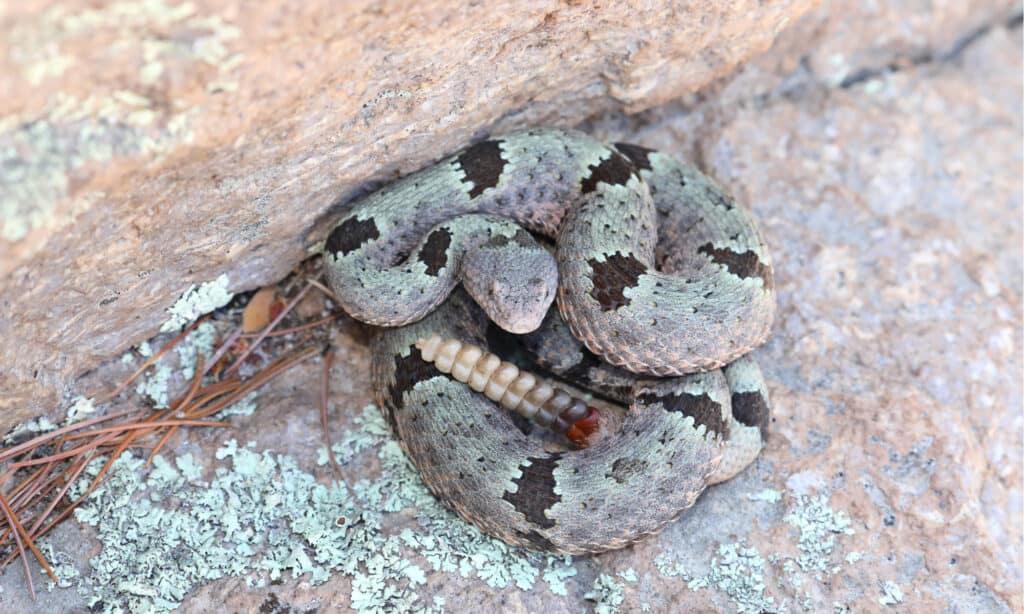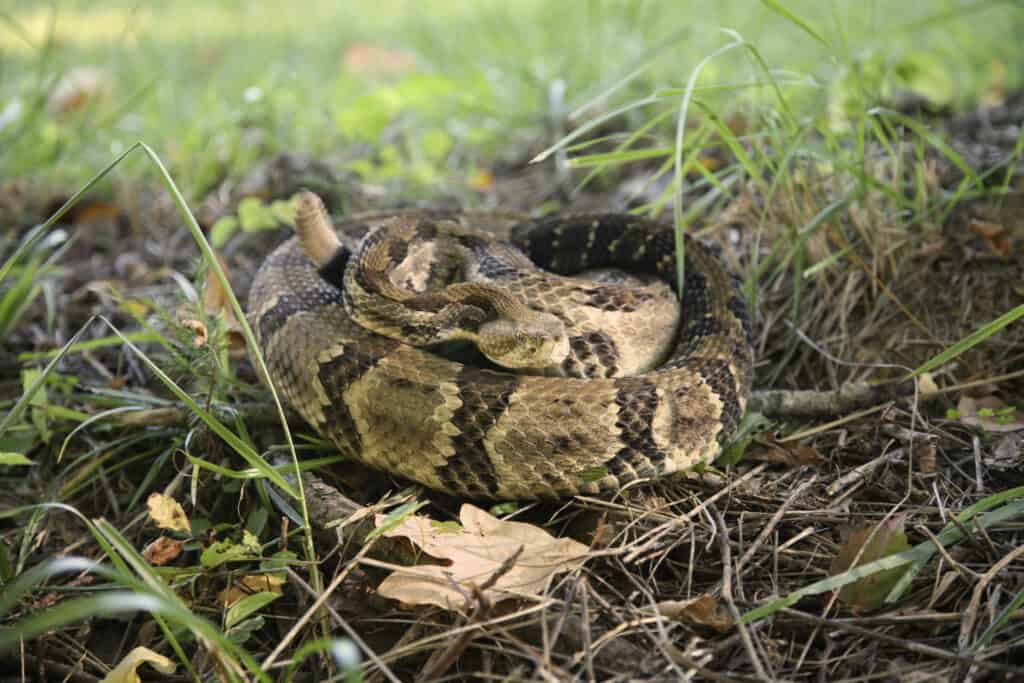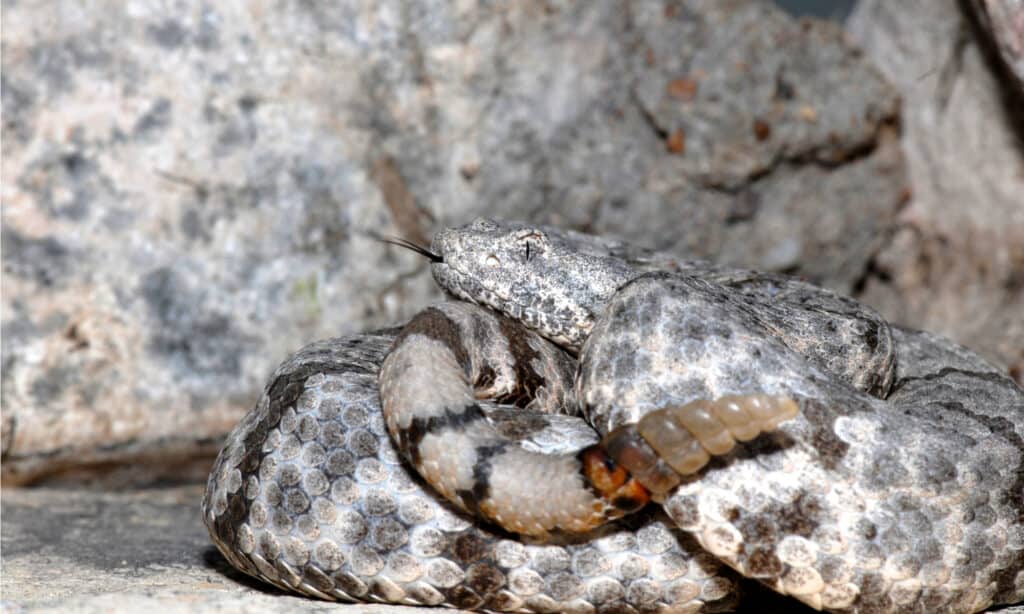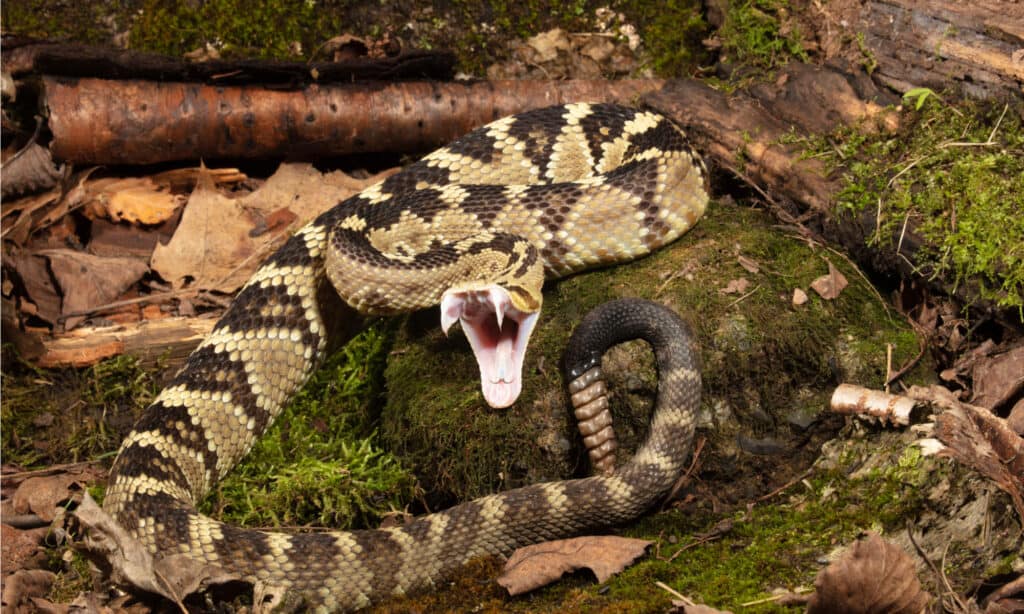There are 90 species of snakes in Texas, and 10 of those are different types of rattlesnakes. This makes the Lone Star State home to the second-highest population of rattlesnakes in the USA, the first being Arizona. Most sightings of rattlesnakes in Texas occur during their breeding season. Therefore, this is also when they are most defensive and aggressive. However, it is unlikely they will attack for no reason; they need to be provoked to go on the defense. Three out of the 10 rattlesnakes found in Texas are protected either federally or in Texas. They include the mottled rock rattlesnake, timber rattlesnake, and banded rattlesnake.
When Are Rattlesnakes in Texas Most Active?

There are many species of rattlesnakes in Texas and they are found throughout the state.
©Frode Jacobsen/Shutterstock.com
Rattlesnakes in Texas come out of brumation once it begins to warm up. Therefore, these snakes will emerge once spring arrives to feed and find mates, which generally occurs between February and early March. This is the time of year when most rattlesnake bites get reported because they are extremely aggressive when mating. So, it’s really important for everyone in Texas to know when these snakes are most active and avoid areas where they are most abundant. Unfortunately, rattlesnakes in Texas are active throughout most of the year because the Lone Star State has a warm climate. But, they are more dangerous in the spring and summer while mating.
Where Are Rattlesnakes Found in Texas?
There are many species of rattlesnakes in Texas and they are found throughout the state. These snakes like to inhabit rocky hillsides, deserts, forests, and flat plains, so it’s best to avoid these areas in the summer as much as possible. However, one of the largest populations of Western diamondback rattlesnakes in Texas inhabits areas around Sweetwater, TX. In fact, this town hosts one of the world’s most horrific rattlesnake roundups.
This festival takes place once a year in March when thousands of tourists descend on the town to hunt and kill rattlesnakes. It’s a tradition that started in 1958 because of the high number of Western diamondbacks in the area, and locals decided to catch and kill them to keep the community safe. However, today we know that this method of population control is not effective, as predators and natural elements keep their numbers in check.
Unfortunately, this rattlesnake roundup is no more than a commercial opportunity for exploiting animal cruelty and parading it as “Conservation.” Once the rattlesnakes are caught, they milk the venom, chop their heads off, and skin them. Every part of the snake is sold its venom, skin, and meat.
When Do Rattlesnakes in Texas Brumate?
Rattlesnakes in Texas go into brumation in the fall. Because snakes are cold-blooded, they need warmth to keep them alive. Being exposed to temperatures below about 40 degrees Fahrenheit can cause damage to their internal organs. So, towards the end of summer, once breeding is done, they bulk up on food, becoming bigger to survive the winter. Once the temperature drops below about 50 degrees Fahrenheit, it’s safe to say you won’t encounter any rattlesnakes in Texas. However, the exact timing of seasonal change will differ depending on the environment and location in the state. Sometimes fall comes early, and sometimes Texas will have a warm winter, meaning the rattlesnakes can stay active longer.
The type of habitat also impacts when these snakes go into brumation. For example, scrublands provide plenty of cover, protecting the rattlesnakes from the elements. However, the desert, which covers most of West Texas, has cold nights because the limited vegetation doesn’t provide protection from the elements. Furthermore, higher elevations like mountains and hills are colder than lower elevation areas. So, needless to say, it’s hard to pinpoint the exact time these snakes will go into brumation.
Nine Types of Rattlesnakes in Texas
Texas is home to eight different species and one subspecies of rattlesnakes: the Western diamondback, banded rock, Mojave, Timber, mottled rock, Prairie, black-tailed rattlesnake, desert Massasauga, and Western Massasauga.
Western Diamondback Rattlesnake (Crotalus atrox)

Western diamondback rattlesnakes are a venomous species of the Viper family.
©Audrey Snider-Bell/Shutterstock.com
The western diamondback rattlesnake is also known as a Texas diamondback, and it is a venomous species of the Viper family. They are found in the southwestern states and Mexico. Unfortunately, this snake is responsible for most of the northern Mexico snakebite fatalities and the culprit for the highest number of snakebites in the USA. The western diamondback has no currently recognized subspecies, so identifying them is easy. For example, these snakes are heavy-bodied, with triangular heads.
Additionally, there are two lines on each side of their face, from their eyes to the jaw. They were named after the dark diamond-shaped patterns on their backs. Furthermore, their tails have white and black bands just under the rattles.
Banded Rock Rattlesnake (Crotalus lepidus klauberi)

The banded rock rattlesnake is one of the smaller members of the rattlesnake species.
©Glenn McCrea/Shutterstock.com
The banded rock rattlesnake doesn’t have a large range in Texas, as they only inhabit El Paso county and the Franklin Mountains. In addition, they are one of the smallest rattlesnakes and a subspecies of rock rattlesnakes (Crotalus lepidus) — as adults Texas they only measure 22 to 24 inches long. Furthermore, the banded rock rattlesnake population in Texas is the only subspecies that is gray. For example, in other areas, males are bright green, and females range from brown to pink. The Texas population has 13 to 20 dark primary bands covering their gray bodies.
Mojave Rattlesnake (Crotalus scutulatus)

The Mojave rattlesnake typically grows to between 3.3 ft and 4.5 ft in length.
©Creeping Things/Shutterstock.com
Found in the deserts of southwestern USA and central Mexico, this highly venomous pit viper is not a snake to mess with. While it was named after the Mojave Desert, it does occur in other areas like desert flats, canyons, rocky hills, mountain slopes, and high deserts. They are medium-sized snakes and can reach lengths of two to four feet. Additionally, they are greenish-gray in color, but in higher areas, their coloring changes to olive green; in lower areas, they are brown or yellow.
Timber Rattlesnake (Crotalus horridus)

Timber Rattlesnakes also go by the names timber rattler and black rattlesnake.
©iStock.com/NajaShots
The timber rattlesnake goes by many names, including:
- Black rattlesnake
- Timber rattler
- American viper
- Eastern rattlesnake
- Canebrake
This snake is a very large pit viper that occurs across the eastern half of the United States. They vary in coloration, but all have dark crossbands that overlay the base, which range in color from shades of brown to yellow to black. Additionally, they have a dorsal strip that varies from tan, chestnut, yellow, and orange. Fully grown adults can grow to lengths of 2.5 to 5 feet long, but their maximum length is around 7 feet.
Mottled Rock Rattlesnake (Crotalus lepidus)

The mottled rock rattlesnake can survive in several types of habitats, including rocky mountains, deserts, shrublands, and pine forests.
©Rusty Dodson/Shutterstock.com
The mottled rock rattlesnake is a venomous snake that varies in size from 1.5 feet to 3 feet long. This snake has a few subspecies including the banded rock rattlesnake, and they occur in some southern states and certain parts of Mexico. They are adaptable snakes and can survive in several types of habitats, including rocky mountains, deserts, shrublands, and pine forests. These snakes are slender, but their coloration differs depending on their environment. For example, they can be green, gray, brown, blue-gray, and a pink hue. They also have widely spaced blotches over their base color, sometimes forming crossbands; they usually have serrated edges, and there are often tiny spots between the blotches.
Prairie Rattlesnake (Crotalus viridis)

Unlike their cousins, the Mojave rattlesnake, prairie rattlesnakes avoid deserts.
©DMartin09/Shutterstock.com
The prairie rattlesnake, also called the Great Plains rattlesnake, is a venomous snake that inhabits areas in the western United States. They range from southwestern Canada to Montana, Idaho, Iowa, Texas, and Mexico. Prairie rattlesnakes prefer residing in prairies and grasslands. However, they also occur in forests, rock ledges, woods, brush, alongside streams, and caves. Unlike their cousins, the Mojave rattlesnake, prairie rattlesnakes avoid deserts.
These elusive snakes usually grow to around three feet long but have a maximum length of almost five feet. The snakes that reach this size are primarily found in Montana, as the average length for these snakes in the Treasure State is four feet. Their skin color ranges from brown to pale green with black or brown blotches with dark and light borders. In addition, their rattle-tipped tails are covered in blotches that merge to form dark rings. Males typically have more rings than females. Lastly, these snakes have a white or pale yellow belly.
Ornate Black-tailed Rattlesnake (Crotalus ornatus)

Black-tailed rattlesnakes are relatively large snakes that can grow up to four feet long.
©Joe McDonald/Shutterstock.com
The ornate black-tailed rattlesnake inhabits areas like western Texas, central New Mexico, the Chihuahuan Desert, and south of the Coahuila and Nuevo Leo states of Mexico. For example, these snakes occupy the mountainous areas of Trans-Pecos in Texas, but natives rarely see them in the Hill Country.
Ornate black-tailed rattlesnakes are relatively large snakes that can grow up to four feet long, but the average is around three feet. However, the record size for these snakes is 52 inches. It is easy to identify the ornate black-tailed rattlesnake but its unique and distinct patterns and coloration. For example, they have dark tails that differ in color from charcoal to jet black. In addition, it looks like someone dipped their heads in black ink because their nose and forehead are pitch black.
Desert Massasauga (Sistrurus tergeminus edwardsii)

Desert Massasauga rattlesnakes prefer to live in prairies consisting of gram grass.
©Matt Jeppson/Shutterstock.com
Massasauga snakes include three species and several subspecies. The desert massasauga variety prefers to live in prairies consisting of grama grasses. These snakes can grow 1.5 to 2.5 feet long, making them medium-sized snakes. They are light gray in color, with dark brown blotches running down their spines. Additionally, they have two to three brown rows on their side. These blotches have black borders, and they usually form crossbands on the tail beneath the rattle. Lastly, their bellies are generally cream or white, scattered in black spots.
Western Massasauga (Sistrurus tergeminus)

Western massasaugas inhabit areas in Arizona, central Oklahoma, Texas, southeast Colorado, and eastern Kansas.
©Nick Kanakis/Shutterstock.com
The western massasauga is a medium-sized rattlesnake that occurs in the wet meadows, woodlands, and marshes of the American Midwest. These snakes inhabit areas in Arizona, central Oklahoma, Texas, southeast Colorado, and eastern Kansas. They can reach 52 inches in length and have a light-brown base with a tow of brown blotches on their backs. Unlike many of its cousins, the western massasauga practices communal denning, also called a hibernaculum.
The photo featured at the top of this post is © Alexander Wong/Shutterstock.com
Discover the "Monster" Snake 5X Bigger than an Anaconda
Every day A-Z Animals sends out some of the most incredible facts in the world from our free newsletter. Want to discover the 10 most beautiful snakes in the world, a "snake island" where you're never more than 3 feet from danger, or a "monster" snake 5X larger than an anaconda? Then sign up right now and you'll start receiving our daily newsletter absolutely free.
FAQs (Frequently Asked Questions)
Where are rattlesnakes found in Texas?
There are many species of rattlesnakes in Texas, so they are found throughout the state, except in the northern panhandle and East Texas. These snakes like to inhabit rocky hillsides, deserts, forests, and flat plains, so it’s best to avoid these areas in the summer as much as possible. However, one of the largest populations of Western diamondback rattlesnakes in Texas inhabits areas around Sweetwater, TX. In fact, this town hosts one of the world’s most horrific rattlesnake roundups. This festival takes place once a year in March when thousands of tourists descend on the town to hunt and kill rattlesnakes.
How many rattlesnake species live in Texas?
Texas is home to nine different species of rattlesnakes: the Western diamondback, banded rock, Mojave, Timber, mottled rock, Prairie, black-tailed rattlesnake, desert Massasauga, and Western Massasauga.
What month do rattlesnakes come out in Texas?
Rattlesnakes in Texas come out of hibernation once it begins to warm up. Therefore, these snakes will emerge once spring arrives to feed and find mates, which generally occurs between February and early March.
Thank you for reading! Have some feedback for us? Contact the AZ Animals editorial team.







